Abdur Shakoor Shah recreated the time the honored love story of Mahua and Malua is his art series “Mahua”. He used folk motifs with vibrant colors and painted the ballad on paper. This 2005 painting goes by the same name as the art series and tells us a part of the story that is closely connected with our culture and heritage. With this brilliance and thick but minimal brush strokes, he brings the characters to life while outlining them to bring out their feature.
This painting is just a sneak peek from the tale of love and illusion. Abdur Shakoor Shah succeeds in painting an ode that connects people from all generations.

Abdus Shakoor Shah
Born in Bogura in 1946, renowned artist Abdus Shakoor Shah completed his Bachelor in Fine Arts from Bangladesh College of Arts and Crafts, Dhaka, in 1970. He completed his Post Diploma in Fine Arts from the M S University of Baroda, Gujarat, India, in 1978 under the India Bangladesh Cultural Exchange Programme Scholarship.
He served as chairman of the Craft Department in the Faculty of Fine Arts at Dhaka University.
Among his many awards notable are Lalitkala Academy Best Prize (1977); the Excellence Award, Tokyo (1991); Diploma Uczestnictwa, Poland (1993); Honourable Mention Award in the 13th National Art Exhibition, Dhaka (1998), Tokyo ACCU competition runner up prize (1998, 2000); Gold Medal in the 15th National Art Exhibition, Bangladesh Shilpakala Academy (2002); UNESCO and Civitella Ranieri Foundation Fellowship, Umbria, Italy (2006) and S M Sultan Padak (2008). Abdus Shakoor Shah is a retired professor of the Faculty of Fine Art, University of Dhaka.
Mahua

Artist Art Style
Abdus Shakoor Shah works with folk motifs and Bengali ballads in his paintings. His work is a complex exploration of metaphors, nuances and meanings. They depict different expressive modes. For over five decades, Shakoor has been persistently experimenting with newer modes of expression. His compositions are natural, as they relate to the world of human experience, and take their strength from human feelings and emotions.
Shakoor’s sketches fall in the category of the simple – where the form is easily reconcilable with the content, and the content is lifted from reality as we experience it. In terms of the composition, these sketches retain only the bare essentials, sometimes employing just a brief line to cover for a whole figure. Yet, there is no doubt about what they want to express, and what they aspire.





